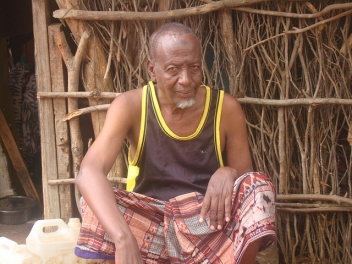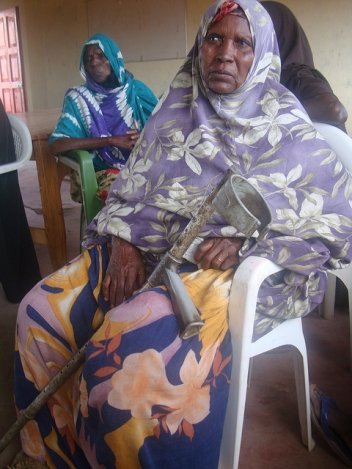 Omer is 67 and used to own businesses in Harar, Ethiopia before he came to Hagadera camp in 2006. He now lives here in a makeshift shelter made of shrubs and sticks with a plastic sheet roof.
Omer is 67 and used to own businesses in Harar, Ethiopia before he came to Hagadera camp in 2006. He now lives here in a makeshift shelter made of shrubs and sticks with a plastic sheet roof.
He is one of the 12,000 older refugees living in the three camps within Dadaab refugee camp in northern Kenya. 10,000 new arrivals reach the camp each week, as desperate people affected by the drought in East Africa seek help.
We visited the Dadaab camp a few weeks ago to assess the situation for older people there. We found them isolated, neglected, traumatised and suffering from poor health, insufficient and inappropriate food, and a lack of shelter.
Before moving to this shelter, donated by a fellow Ethiopian who left for the US, Omer had been sheltering in a mosque for two years. He complains of pain in his left ear (which limits his hearing) and suffers from kidney problems.
“I live like a beggar and eat the same food as donkeys”
When asked about his family, he said: “I have lost contact with my family.” He added that his son 17, had also arrived in Kenya, but left Dadaab camp on seeing the difficult conditions here and has not been heard of since.
“I have no one here and I live like a beggar. I rely on my neighbours from Ethiopia who help collect the food rations and give me food when I run out of my own.
“The food I receive here is for horses and donkeys. Since I moved here I received one blanket, one mattress but I have not been given any utensils, not even a cup to drink water with.
“My main problem is not getting enough food that I like and my poor health. Although I get medicines for temporary relief, I am sick again as soon as I run out of drugs.”
“Life in Somalia was better than here”
Unwilling to be photographed, we also met Daher Ali, 70, in the hospital run by Medicins Sans Frontieres (MSF). He has lived in the camp for the last 10 months without a family as his wife and three children remained in Somalia.
“My poor health is the main reason I came here. I have ulcers and suffer from incontinence. I was a farmer and pastoralist but because of drought all my animals died and was left with nothing.
“For those with animals and family, life in Somalia was better than what we have here, despite the conflict.”
Dadaab camp is currently overflowing with a population of more than four times the capacity it was designed for living in three camps.
During our June visit, the population was estimated to be 360,000. Of this, more than 12,000 are estimated to be older people.
Drought is pushing more refugees to flee the country, further congesting the camp. An estimated 10,000 people are arriving in the camp every month, according to UNHCR.
June alone saw more than 30,000 new arrivals, three times that of previous months.
Older people face multiple hardships
Our visit highlighted several key problems that older people candidly spoke of, and which the larger aid agencies working the camps confirmed.
For example poor mobility and disability affect 13,000 people across the three camps.
Of these, 2,380 are older people (17% of the overall population of people with disabilities).
According to Handicap International, visual impairment stands out as the most common form of disability. Other common health problems include physical disability, hearing, speech and mental health – caused by lack of immunisation and gun-related violence.
 Hawo Yusuf Hussein, 68 lost her leg after being shot by warring groups. She moved to the camp after travelling for four months where she lives with her son and grandson.
Hawo Yusuf Hussein, 68 lost her leg after being shot by warring groups. She moved to the camp after travelling for four months where she lives with her son and grandson.
She says: “Life is very difficult here we cannot access any help. If there is any priority, I would have said food is the main one. My disability affects me. I cannot sleep. I am in constant pain and I do not get any treatment.
“While I was in Somalia I was active. Since I lost my husband 20 years ago, I earned a living by making mats to sell.
“I had nine children. Five died in Somalia and two are still there.”
Sensing the danger she has putting herself and her children in, Hawo left for northern Kenya on her own. However, two of her children followed her and they now live together in the camp.
“In Somalia I had a relative who used to send me money from abroad but have since lost his contact. I am now entirely depend on food rations given by the camp.”
Mobility aids such as wheelchairs and walking sticks are unavailable for the majority who need them. And in any case, the sandy ground in the camp means wheelchairs, walking frames and other mobility aids are very difficult to operate.
Lack of suitable help for older people
Overall invisibility: Older people have no voice. They do not get the opportunity to air their views because agencies place no specific emphasis on this age group.
When new arrivals come, larger agencies rapidly identify victims of gender violence, malnutrition, unaccompanied children, and undertake general registration.
Older people are lumped with the rest of the arrivals, despite their poor health, frailty and weak physical and mental health.
Distribution centres have no special lines for older people and do not prioritise them. Arrival centres are crowded and chaotic, with a lot of pushing and shoving.
Insufficient food: Older people told us they did not have enough decent quality food. With the increased influx of refugees, food rations are continually reduced.
Moreover, the food that is distributed mainly includes maize, beans and wheat flour, with very small quantity of cooking oil and salt. This is not suitable nor palatable for the majority of older people.
As a result a number of older people are malnourished and this is confirmed by various agencies. Although the International Rescue Commitee has a targeted children’s supplementary feeding programme, no such programme exists for older people.
Shelter: Large numbers of older people are living in poor shelter because they are unable to make bricks and erect a shelter. Some live in makeshift structures made of wooden sticks with no plaster whatsoever, exposing them to adverse weather conditions.
New arrivals are forced to remain on the outskirts of the camps with no appropriate shelter, often sharing cramped spaces with other relatives.
Poor health and limited access to healthcare: None of the camps’ health facilities have special reception areas or prioritisation for older people. Many older people have chronic conditions such as high blood pressure and diabetes, but are not on drugs for managing these conditions.
The lack of ambulances means frail, weak and those with disabilities cannot reach the health facilities. There are trained community health workers among the refugees but they do not have any specific skill to visit and advise older people. The emphasis is on identifying malnourished children.
Inaccessibility of sanitation facilities: The areas in which the camps are set up are prone to flooding so toilets seats have been raised. Older people told us they cannot climb these raised seats and thus many have resorted to using plastic containers.
Isolation and loneliness: There are a number of unaccompanied older people who depend on the support of others who collect their food rations and help with cooking. These older people live in the most appalling situations, with inadequate shelter, bedding and personal hygiene facilities.
Protection: Some older people have reported verbal, physical, sexual abuse in the camps.
Older men acknowledged that wife beating is common and rape also happens, to a lesser degree on older women as well. Some even said that rape of older women is not reported and even if it is, no action is taken.
Some older people commented they are no longer respected and valued by their families and communities.
What older people in Dadaab camp need
More, better quality food: Older people need improved food rations. Corn Soya Bean fortified with oil and sugar would provide better nutrition for older people. We will ask the major agencies to start a
supplementary feeding programme specifically for older people.
Less isolation: Linking lonely older people with foster families can also help improve their emotional and physical needs.
Shelter and bedding: Materials to erect suitable shelters, blankets and mattresses.
Access to healthcare: Older people need outreach services for the bedridden and those with poor mobility. Eye screening and treatment of preventable blindness is also crucial.
Community-owned donkey carts (or donkey ambulances) would help older people to get around the camp, particularly to get to health clinics or hospitals.
Sanitation: Accessible toilets with ramps and raised seats can go a long way in providing older people with more dignity.
What will HelpAge do now?
We have now completed an assessment of what older people living in Dadaab camp need. We will now:
- share our recommendations with UN agencies and other agenices in the camp and in Geneva
- work on raising funds and designing a programme to help older people in the camp
- continue to work with other, larger agencies in the camp, trying to influence them to include older people in their budgets and programme work
- improve the skills of aid workers, as those we interviewed said they lacked information, skills and training on the rights and needs of older people.
The Disasters Emergency Committee (DEC), an umbrella organisation for the major aid agencies in the UK, has launched a crisis appeal to raise funds for drought-affected people in East Africa. If you would like to help, please donate to the DEC East Africa appeal.
